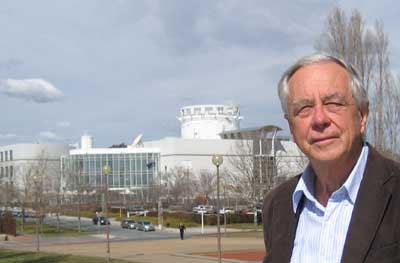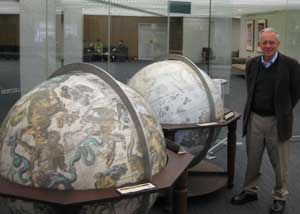| |||
|
Prof. Bill Compston is a geochronologist. As such he is also a geologist, geophysicist and geochemist. All aspects of earth science enter into determining the age of the earth's rocks, and those from the moon too. The early evolution of the earth and the moon remain among Bill's research interests. He is a world authority on rock age determination. He started his research in the early 1950s, among the first using the then new techniques employing radioactive isotopes. These techniques were derived from the Manhattan Project that built the first atomic bomb in the US in the 1940s. Mark Oliphant (later Sir Mark), who had worked on the Project, returned to Australia in the late 1940s and actively promulgated their use in new lines of research in Australian laborotories.
Bill's research investigated the ages of ancient rocks, and the compositions of ancient oceans and atmospheres. He became recognised as a world leader in this field, and in 1969 he and his laboratory were one of a handful chosen by NASA to determine the age of the first moon rocks brought back to earth by Apollo 11. They found ages of 3.8 billion years. This work was successfully repeated for subsequent Apollo missions, the ages extending from 3.3 to as far back as 4.4 billion years. And Bill was elected Fellow of the Australian Academy of Sciences. Following the early lunar work Bill saw the need to replace the wet chemistry in the dating process by in situ instrumental microanalysis, and developed and built the Sensitive High Resolution Ion Microprobe (SHRIMP). This was a difficult task for both technical and institutional reasons, but it worked so well researchers queued up to use it. It has played a key role in identifying and determining the ages of the oldest rocks in the world. The first pre-4 billion years old zircons were found by Derek Froude, an Olympic athlete, at Mt Narryer in the Murchison Province of Western Australia. Zircons from Jack Hills in the same area so far take the honours as the oldest at 4.4 billion years, implying the earth's crust formed surprisingly soon after the planet itself. The oldest whole rocks hail from Canada and were determined by SHRIMP in 1989 at 4.0 billion years. Amongst many honours, Bill was elected Fellow of the Royal Society of London in 1987. In retirement he is still working on improving the techniques that have made his career.
Music in this podcast includes extracts from Michael Kieran Harvey playing his own compositon for piano, Pink Nautilus, from his album rabid bay, 2004, courtesy of Move Records.
|
|||
In my study: notes on The Cradle of Humankind; see In my study No.12 (6.4 Mb; 6' 59"). William Compston, FRS: selected publicationsNature numbers 184, 186 & 198 for early rock dating breakthroughs; and No. 321 for the Jack Hills ancient zircons. See also: Froude, D.O., Ireland, T.R., Kinny, P.D., Williams, I.S. and Compston, W. 1983. Ion microprobe identification of 4100 to 4200 Ma-old terrestrial zircons. Nature, 304, 616-618. Geochim. et Cosmochim. Acta 1970 - 1975, Science No. 28, 1972, for papers on the dating of lunar material. M.W. McElhinny (ed.): The Earth: It's Origin, Structure and Evolution; Chapter 12: Sr-Isotope Evolution of Granitoid Source Rocks, W. Compston and B.W. Chappell. Academic Press, 1979. Australian Journal of Earth Science 34: Compston, W., Williams, I.S., Jenkins, R.J.F., Gostin, V.A. and Haines, P.W. 1987. Zircon age evidence for the Late Precambrian Acraman ejecta blanket. (Dating of the Lake Acraman, South Australia, large meteorite impact.) For more about Prof. Bill Compston see: Note: There is one other reference I feel compelled to add to the above list. During the interview Bill Compston and myself both confessed to still having our copies of "Dana's Mineralogy". It is the "old testament" of mineralogy, a treasure. Reference: A Textbook of Mineralogy, with an extended treatise on Crystallography and Physical Mineralogy by Edward S. Dana, John Wiley and Sons, New York, 1877-1932 (4th edition). All material, unless otherwise stated, is © Copyright Craig Robertson, 2008 Information on this page may be accessed and read or listened to for personal use. The material may not be copied or communicated to other parties without permission. |

